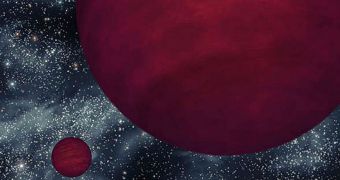Researchers at the University of Hertfordshire led an international team of astronomers in making one of the most peculiar discoveries in a long time. The group managed to identify a sub-stellar body technically known as a brown dwarf right in our neighborhood, inside the Local Fluff. The space object may very well be the coolest of its kind ever discovered, the team believes, given that its surface temperature is just of 200 degrees Celsius. The finding was made using the Hawaii-based United Kingdom Infrared Telescope (UKIRT), Space Fellowship reports.
One of the weirdest things about this particular structure is the fact that it shines either in blue light, or in red light, depending on what types of filters are used on the telescope making the observations. This brown dwarf has been given the catchy name SDSS1416+13B by astronomers, because it orbits a larger, hotter brown dwarf called SDSS1416+13A. The parent body was detected some time ago using the Sloan Digital Sky Survey, but the smaller one was not that quick to reveal itself. It can only be viewed in a very specific portion of infrared wavelength, called mid-infrared, and that is one of the main reasons why finding it took so long.
“This looks like being the fourth time in three years that the UKIRT has made a record breaking discovery of the coolest known brown dwarf, with an estimated temperature not far above 200 degrees Celsius. We have to be a bit careful about this one because its colors are so different than anything seen before that we don’t really understand it yet. Even if it turns out that the low temperature is not quite record breaking, the colors are so extreme that this object will keep a lot of physicists busy trying to explain it,” UH School of Physics, Astronomy and Mathematics expert Dr. Phillip Lucas explains. The pair is located anywhere between 15 and 50 light-years away from our solar system.
The first glimpses of the cool companion were caught during the UKIRT Infrared Deep Sky Survey (UKIDSS), which was led by UH expert Dr. Ben Burningham. Infrared data, later collected by the Subaru Telescope, revealed the space structure to be a special class of brown dwarfs known as a T dwarf. This means that the atmosphere surrounding the body's core features an enormous amount of methane, but that the light its surface emits is only visible in select wavelengths, including mid-infrared.
“The fact that it is a binary companion to a warmer brown dwarf that also has an unusual spectrum is helping us to fill in some gaps in our understanding. It seems likely that both brown dwarfs are somewhat poor in heavy elements. This can be explained if they are very old, which also fits with the very low temperature of the faint companion,” Dr. Burningham adds. But no one really expected this body to be understood at first attempt. By definition, brown dwarfs are space structures halfway between planets and stars, larger than gas giants, but smaller than fully fledged stars.

 14 DAY TRIAL //
14 DAY TRIAL //